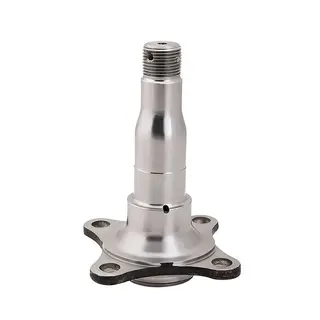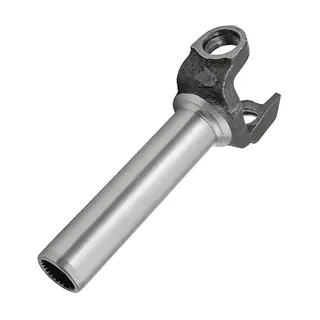In the precise construction of automobile engines, the connecting rod plays an indispensable role and is regarded as the "heart component" of the engine. It not only connects the piston and the crankshaft, but also converts the reciprocating linear motion of the piston into the rotary motion of the crankshaft, thereby outputting power to drive the car forward. This article will deeply explore the forging process, material selection, and common problems and solutions in the production process of the connecting rod, helping readers fully understand this key forged component.
The working environment of the connecting rod in the engine is extremely harsh. Its working temperature is usually between 90°C and 100°C, and the operating speed is as high as 3000–5000 revolutions per minute. Under such high-speed operation, the connecting rod bears sharply changing dynamic loads, and the stress condition is complex and severe. Therefore, the connecting rod must have high strength to ensure stable operation under such harsh conditions. At the same time, in order to maintain the balance of the crankshaft at high speed, the dimensional accuracy and mass tolerance of the connecting rod must be strictly controlled. Any slight deviation may affect the performance and service life of the engine.
The manufacturing process of the connecting rod is complex and precise, and the forging process is its core link. Due to the complex shape of the connecting rod, the forging process faces many challenges, and even slight carelessness may lead to quality problems. Therefore, the connecting rod industry has been continuously exploring and improving the forging process to meet the technical performance and usage requirements of the product while reducing cost and improving efficiency.
Forging is the key link in the manufacturing of connecting rods, and its main processes include blanking, heating, roll forging, and die forging. Different blanking methods have their own advantages and disadvantages. The advantage of using a band saw machine for blanking is that the working conditions are good, and both ends of the billet are flat and free of defects, but the production efficiency is low, and there is saw kerf loss. The bar shearing machine blanking method has high production efficiency and no saw kerf loss, but the ends are prone to flattening, hoof-shaped deformation, central cracking, end burrs, and stress concentration.
To ensure high-quality die forgings of connecting rods, heating quality is crucial. At present, the intermediate frequency induction heating method is widely used. This method is easy to automate and can effectively improve the working environment. The heating temperature varies depending on the raw material. For example, commonly used materials such as 40Cr, 45Mn, and 35Mn2 generally have a heating temperature in the range of (1230±20)°C. During the heating process, problems such as overheating or too low billet temperature may easily occur. Therefore, the intermediate frequency heating furnace must be equipped with a temperature control device to ensure that the heating temperature of the billet is within the specified range and to avoid damage to the heating furnace.
The roll forging process plays an important role in the production of connecting rod die forgings. Its main function is billet preparation and the reasonable distribution of metal volume to match the pre-forging die cavity. Roll forging has the advantages of high material utilization, good working conditions, easy mechanization and automation, low investment, high production efficiency, and low production cost.
However, some problems may also occur during roll forging, such as folding in the rod part, inconsistent bite points in each pass, too small transition radius (R), rough billet surface, unevenness, scratches, spiral defects, or small localized burrs. These problems may lead to folding, wrinkles, and underfilling defects in the connecting rod product. To solve these problems, it is necessary to reasonably determine the shape and size of the roll billets in each pass during roll forging die design, reasonably distribute the elongation coefficient of each pass, determine an ideal groove system, accurately calculate the sectional size and groove size of each billet, and improve the mold processing level and manufacturing accuracy. At the same time, it is necessary to ensure that the roll forging machine and manipulator are always in good condition, carefully observe changes on the surface of the roll forging die, and carry out timely maintenance and repair.
The die forging process generally includes three steps: flattening, pre-forging, and final forging. The purpose of flattening is to prevent folding in the inner hole and to facilitate the stable placement of the pre-forging. During pre-forging, it is necessary to ensure that the billet is placed in the pre-forging die cavity, covering the cavity in the length direction to prevent misplacement that could cause end defects to be pressed into the cavity to form folds or underfilling caused by insufficient material. During final forging, the thickness dimension must be strictly controlled according to the drawing of the final hot forging, and the slider height or striking energy must be adjusted according to the equipment type, while also controlling the final forging temperature.
Common problems during die forging include cracks, folds, oxide scale, mismatches, surface defects, and excessive residual flash height. Passenger car connecting rods, in particular, require more stringent quality tolerances. To solve these problems, it is necessary to design the preheated forging and pre-forging die cavity of the connecting rod reasonably so that it achieves the best match with the final forging die cavity, pay attention to the parameter selection and die cavity design of the I-beam section of the connecting rod rod, and reasonably design the shape and size of the pre-forging large-end hole splitting boss. Timely maintenance of the forging die cavity, improvement of mold surface roughness, and manufacturing accuracy are also required.
After the connecting rod is die-forged, there will be flash and burrs, so punching and trimming are necessary. These processes are usually completed on trimming presses using the residual heat of the forging. Common problems in trimming and punching include uneven residual flash, trimming deformation, deviation of the center distance between large and small end holes, and large wall thickness differences in the small end. The main causes of these problems include mismatch between the upper and lower dies, excessive clearance, worn die edges, and mismatch between the forging die and trimming die. To solve these problems, it is necessary to ensure proper die alignment, timely repair of die edges, and control of trimming and punching process parameters.
The material selection of connecting rods has a crucial impact on their performance and service life. According to different classification methods, connecting rods can be divided into quenched and tempered steel connecting rods and non-quenched and tempered steel connecting rods, as well as split-type connecting rods and integral-type connecting rods.
Quenched and tempered steel connecting rods refer to those that need to undergo quenching and high-temperature tempering heat treatment after forging to meet performance requirements. These connecting rods have high strength and good toughness, can withstand large loads and impact forces, and are suitable for high-performance engines.
Non-quenched and tempered steel connecting rods are those that achieve the required properties by controlling the cooling rate after forging. Their production cost is relatively lower, but their strength and toughness are slightly inferior to quenched and tempered steel connecting rods, making them suitable for engines with lower performance requirements.
Split-type connecting rods refer to those whose rod body and cap are separated during forging. The advantages of this type are relatively simple manufacturing processes and lower cost, but the connection strength and reliability are weaker.
Integral-type connecting rods refer to those whose rod body and cap are forged as a single piece and then separated in subsequent machining. Integral-type connecting rods offer higher strength and reliability but involve more complex processes and higher costs. According to the separation method, integral connecting rods can be further divided into fracture-split connecting rods and sawn connecting rods.
Fracture-split connecting rods are separated through the fracture-splitting process, offering high machining precision and ensuring dimensional accuracy and mass tolerance. Sawn connecting rods are separated by cutting, which has a relatively simpler process and lower cost, but slightly lower machining precision compared to fracture-split connecting rods.
Quality control is a critical part of the connecting rod forging process. To ensure product quality, a series of control measures must be implemented, and the forging process must be continuously improved.
Heating is a key step in forging, and the quality of heating directly affects the quality of the connecting rod. To ensure heating quality, the heating temperature must be strictly controlled to avoid overheating or low temperatures. The medium-frequency induction heating furnace must be equipped with a temperature control device, which should be regularly calibrated and maintained to ensure temperature accuracy. Meanwhile, heating temperature should be reasonably adjusted according to different raw materials to ensure that the billet temperature remains within the specified range.
Roll forging is one of the important processes in connecting rod forging, and its quality directly affects the final product. To ensure roll forging quality, the roll forging dies must be designed properly to ensure that the billet shape and dimensions of each pass are reasonable, elongation coefficients are well distributed, and groove designs are optimal. In addition, the machining accuracy and manufacturing precision of the molds must be improved to ensure dimensional accuracy and repeatability. During production, the roll forging machine and manipulator must remain in good condition, and changes in die surfaces must be carefully observed and promptly repaired.
The die forging process has a decisive influence on connecting rod quality. To ensure die forging quality, the preheated forging and pre-forging die cavity of the connecting rod must be reasonably designed to achieve the best match with the final forging die cavity. The parameters and die design of the I-beam section of the connecting rod must be carefully selected, and the shape and size of the pre-forging large-end boss must be rationally designed. During production, molds should be regularly adjusted, and matching accuracy must be ensured. Timely maintenance of die cavities, improvement of surface roughness, and manufacturing precision are also required. The final forging temperature and striking force of the equipment must be controlled to maintain stable production rhythm.
The trimming and punching process is the final stage of connecting rod forging, and its quality directly affects the final product. To ensure trimming and punching quality, proper die matching must be maintained, die edges must be repaired promptly, and process parameters must be controlled. In addition, trimming and punching equipment must be regularly inspected to ensure good working condition and avoid quality problems caused by equipment failure.
As a key component of automobile engines, the connecting rod's forging process is complex and precise, with strict quality requirements. Through reasonable material selection, optimized forging processes, strengthened quality control, and continuous improvement, the quality and performance of connecting rods can be effectively enhanced to meet the requirements of automotive engines. With continuous technological progress and process improvement, the connecting rod forging industry will develop toward higher efficiency, higher quality, and lower energy consumption, providing strong support for the automotive industry.
In summary, connecting rod forging is a systematic engineering process that requires comprehensive consideration of material selection, process design, and quality control. Only through continuous technological innovation and improvement can cost reduction and efficiency enhancement be achieved while meeting product performance and usage requirements, thereby ensuring reliable operation of automobile engines.



